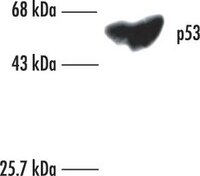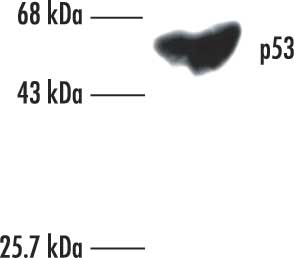OP43 Sigma-AldrichAnti-p53 (Ab-6) (Pantropic) Mouse mAb (DO-1)
This Anti-p53 (Ab-6) (Pantropic) Mouse mAb (DO-1) is validated for use in Frozen sections, Immunoblotting, ICC, IP, Paraffin sections for the detection of p53 (Ab-6) (Pantropic).
More>> This Anti-p53 (Ab-6) (Pantropic) Mouse mAb (DO-1) is validated for use in Frozen sections, Immunoblotting, ICC, IP, Paraffin sections for the detection of p53 (Ab-6) (Pantropic). Less<<お勧めの製品
概要
| Replacement Information |
|---|
主要スペック表
| Species Reactivity | Host | Antibody Type |
|---|---|---|
| Fe, H | M | Monoclonal Antibody |
価格&在庫状況
| カタログ番号 | 在庫状況 | 包装 | Qty/Pk | 価格 | 数量 | |
|---|---|---|---|---|---|---|
| OP43-100UGCN |
|
樹脂アンプル | 100 μg |
|
— | |
| OP43-20UGCN |
|
樹脂アンプル | 20 μg |
|
— |
| Product Information | |
|---|---|
| Form | Liquid |
| Formulation | In 0.05 M sodium phosphate buffer, 0.2% gelatin. |
| Negative control | SK-OV-3 cells or normal skin tissue |
| Positive control | A431 cells or breast carcinoma tissue |
| Preservative | ≤0.1% sodium azide |
| Quality Level | MQ100 |
| Physicochemical Information |
|---|
| Dimensions |
|---|
| Materials Information |
|---|
| Toxicological Information |
|---|
| Safety Information according to GHS |
|---|
| Safety Information |
|---|
| Product Usage Statements |
|---|
| Storage and Shipping Information | |
|---|---|
| Ship Code | Blue Ice Only |
| Toxicity | Standard Handling |
| Storage | +2°C to +8°C |
| Do not freeze | Yes |
| Packaging Information |
|---|
| Transport Information |
|---|
| Supplemental Information |
|---|
| Specifications |
|---|
| Global Trade Item Number | |
|---|---|
| カタログ番号 | GTIN |
| OP43-100UGCN | 04055977227543 |
| OP43-20UGCN | 04055977227123 |
Documentation
Anti-p53 (Ab-6) (Pantropic) Mouse mAb (DO-1) 試験成績書(CoA)
| タイトル | ロット番号 |
|---|---|
| OP43 |
参考資料
| 参考資料の概要 |
|---|
| El-Deiry, W.S., et al. 1994. Cancer Res. 54, 1169. Greenblatt, M.S., et al. 1994. Cancer Res. 54, 4855. Legros, Y., et al. 1994. Oncogene 9, 2071. Barak, Y., et al. 1993. EMBO J. 12, 461. Kastan, M.B., et al. 1992. Cell 71, 587. Kuerbitz, S.J. 1992. Proc. Natl. Acad. Sci. USA 89, 7491. Lane, D.P. 1992. Nature 358, 15. Vojtesek, B., et al. 1992. J. Immunol. Meth. 151, 237. Kastan, M.B., et al. 1991 Cancer Res. 51, 6304. |
カタログ
| タイトル |
|---|
| Caspases and other Apoptosis Related Tools Brochure |
引用
| Title | |
|---|---|
|
|
| データシート | ||||||||||||||||||||||||||||||||||||||||||||||||||
|---|---|---|---|---|---|---|---|---|---|---|---|---|---|---|---|---|---|---|---|---|---|---|---|---|---|---|---|---|---|---|---|---|---|---|---|---|---|---|---|---|---|---|---|---|---|---|---|---|---|---|
|
Note that this data sheet is not lot-specific and is representative of the current specifications for this product. Please consult the vial label and the certificate of analysis for information on specific lots. Also note that shipping conditions may differ from storage conditions.
|








